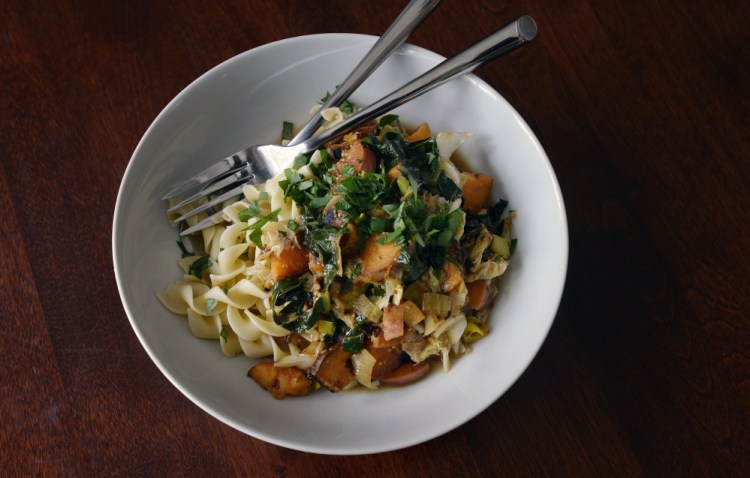At this stage of the industrial food game, we’re all pretty used to having fresh berries, crisp bell peppers, greenish string beans, pink tomatoes and skinny asparagus bundles packed into produce aisles come January. But most of us also know full well that nature intended these to be tabletop treats in Maine only when the weather doesn’t require we don both L.L. Bean under- and outerwear.
Bypassing these perishable goods trucked in from California, Chile and Mexico doesn’t have to be a sacrifice. Reposition the proposition as a celebration of cellared root vegetables and hearty winter squash; an embracing of sweet storage apples and tart local cranberries, or an exploration of just how many different ways you can use a head of cabbage in a single week.
If you look at it from a culinary technique point of view, fruits and vegetables naturally available to Mainers this time of year – via both winter farmers markets and in growing numbers as local produce sold in mainstream supermarkets like Hannaford and Shaw’s – are tailor made for comforting wintertime casseroles, stick-to-your-ribs stews, cinnamon-scented cakes and pies, and low and slow braises that make wintertime eating so wonderful.
Personally, I tend towards ragouts for accommodating cold weather vegetables that make their way home with me. Ragout is a semi-slow-cooked French-style stew made with meat or fish and vegetables — or even just vegetables – that can be eaten on its own or bulked up with an interesting starch like fried polenta, couscous, spätzle, or noodles made with a local flour.
While I’ve provided specific weights and measures for Honey Mustard, Sweet Potato and Cabbage Ragout, pulling off a winter vegetable ragout is really more about the process than the recipe. The secret centers on layering flavors. You start with cooking chopped root vegetables – carrots, fingerling potatoes, parsnips, rutabagas, sweet potatoes, turnips or yams – in a deep Dutch oven with equal amounts olive oil and butter and a sprinkling of salt. You cover the pot, and when those become just tender, you push them to one side and add an equal weight of quicker cooking winter vegetables – cauliflower pieces, quartered Brussels sprouts, shredded cabbage or sliced mushrooms – with a bit of butter, a glug of oil and pinch more salt. Spread these vegetables across their half of the bottom of the pan to brown nicely before stirring in aromatic vegetables like onions, shallots, leeks or garlic and letting them soften and mingle their flavor with the longer-cooking ones.
At this point, you’ve spent about 40 minutes prepping and cooking the vegetables. You can choose to cool the ragout off and store it for use later in the week when you need dinner on the table in 10-minutes flat. Or you can finish it immediately with a flavor-boosting sauce comprising two parts citrus juice to one part each vinegar, local sweetener and distinctive flavor agent such as zest, mustard, rosemary or dried chilies. At this point, I also add a smattering of even quicker cooking bright green vegetables to visually brighten the dish, such as arugula, shredded kale or chard, or spinach or frozen peas. If you are serving the ragout over a starch of some sort, loosen it here with a warm cup of good vegetable stock, a good stir and five minutes resting time.
Whether you eat the ragout immediately or save it for later in the week, trust me, you’re not going to miss those unseasonable vegetables at all.
Christine Burns Rudalevige is a food writer, a recipe developer and tester and a cooking teacher in Brunswick. Contact her at: cburns1227@gmail.com.
Send questions/comments to the editors.



